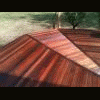I have seen the effects of washers in my area who have (according to the customers) used only bleach when performing a house wash.
The results have been chalky siding. My guess is due to lack of sufficient rinsing.
Many will argue to the effectiveness of their process vs others and say rinsing well is enough,
but I want each of you who contend this to do an experiment:
Take your hand and dip it into your solution and then proceed to rinse it off.
Time how long it takes to get the slipperiness to stop and you get finger tack.
Now, smell your hand. Still smells like bleach doesn't it!?!?
Stick your hand back into the rinse water stream and rub your fingers together, they will feel slippery again even though you just spent a few minutes rinsing them.
This is to illustrate the fact that bleach in the concentrations many are using is going to require a lot more time than they have probably spent on their customers house rinsing.
Three things are missing from an effective house wash solution that just uses bleach alone.
1. A Surfactant; this helps to lift the pollutants and keep them from re-adhering to the surface. Detergents have surfactants in their formulations.
2. An alkaline builder (a degreaser additive containing 1 or more of the following: tsp, butoxyethenol, sodium hydroxide); these help increase the alkalinity range meaning it will react to more surface pollutants than just bleach alone. Remember, high alkalinity is not the answer, range of alkalinity is.
3. A rinse aid; this helps to ensure cleaner rinsing and requires much less time to rinse to achieve the same neutral surface so that once you leave, there is nothing left to become active again in the next dew or rain cycle and continue to eat away at the surface of the clients home.
A 4th ingredient which some have mentioned is a foaming agent. This helps to make your solution more effective cause it holds it on the surface longer and takes longer to dry on warmer days.
I tote around a 5 gallon container which is completely closed except for a vent to allow air in while the solution is being drawn out. In that container is 3-1/2 gal of water to start. 1/3 gal of 6% bleach, 1 scoop of a detergent (agitate to completely dissolve powder) , 8-16 ounces of a liquid degreaser concentrate. 4-6 oz. of a foaming agent. 2-4 oz of a rinse agent. Then the container is topped off with water to the fill mark.
This solution is injected with an m-5 w/o any proportioners at 115* for vinyl siding, 130* for aluminum, E.I.F.S./Dryvit/Stucco/Hardiplank or other cementatious siding materials.
This mix also works fine for most stains on gutters and can be applied at the same time. Brushing is necessary to remove electrostatic bonded asphalt material streaks. (you know these, vertical streaking that laughs at your high bleach content mix)
For light mildew/algae, injecting and rinsing is sufficient. For heavier growth, subsequent application(s) may be necessary with brushing to help remove carbon deposits as well.
Rinse until you no longer see any bubbles generated by the cascading water and do the finger test. slippery skin=chemical still present, tacky skin=clean.
Have fun!
Rod!~






Recommended Comments
There are no comments to display.